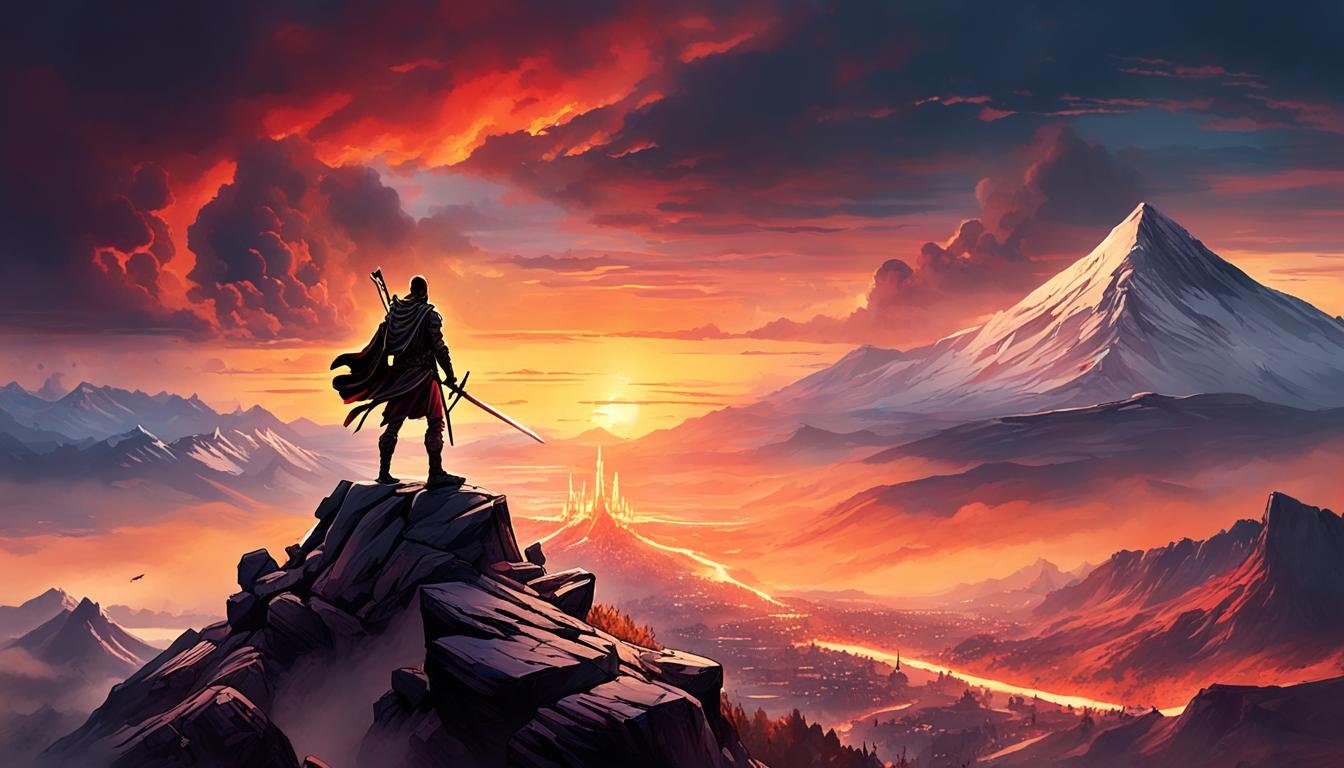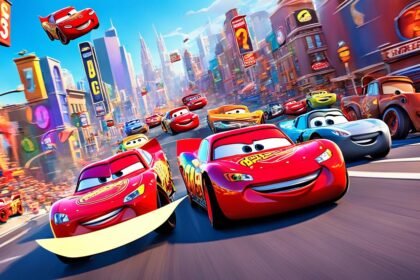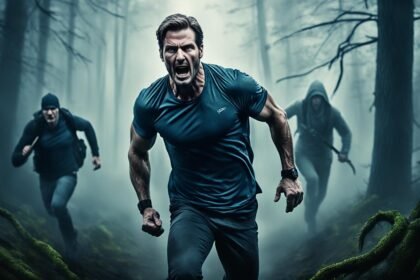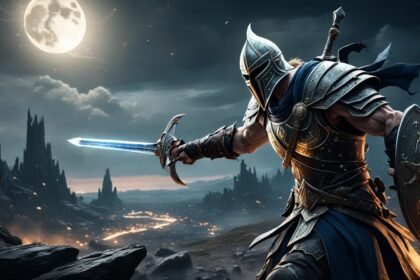In J.R.R. Tolkien’s epic, The Lord of the Rings: The Return of the King, armies face off in a final, world-changing war. This story, also a film directed by Peter Jackson, captivated global audiences. It focuses on Frodo Baggins and Sam as they try to destroy the One Ring in Mordor.
This movie is known for its amazing special effects and deep, engaging world. Through these, it brings Tolkien’s story to a thrilling end.
Key Takeaways:
- The Lord of the Rings: The Return of the King is the final installment of J.R.R. Tolkien’s epic tale and directed by Peter Jackson.
- It follows the journey of Frodo Baggins and Sam as they seek to destroy the One Ring in the heart of Mordor.
- The movie combines captivating visuals with a richly developed world and compelling characters.
- It is a fantasy epic that has garnered critical acclaim and won numerous awards.
- The themes of sacrifice, courage, and the triumph of good over evil resonate throughout the film.
The Lord of the Rings: The Return of the King has made a lasting impact with its epic tale, stunning visuals, and deep themes. It stands as a tribute to Tolkien’s legacy and Peter Jackson’s creative vision.
About the Movie
The Lord of the Rings: The Return of the King is a movie by Peter Jackson. It won 11 Academy Awards, like Best Picture and Best Director. The film ends J.R.R. Tolkien’s epic story with an epic battle.
It shows a fight between good and evil for Middle-earth’s future. The movie cost $94 million to make, filled with amazing effects and a great story that drew people in.
| Release Dates | December 1, 2003 (Embassy Theatre) December 17, 2003 (United States) December 18, 2003 (New Zealand) |
|---|---|
| Countries of Production | New Zealand, Germany, United States |
| Languages | English |
| Running Time | 201 minutes |
| Awards | Won all eleven awards for which it was nominated at the 76th Academy Awards, including Best Picture |
| Box Office Revenue | $1.156 billion |
It was released in 2003 and made over $1.1 billion worldwide. This made it the top money-making film of 2003. It’s also among the top-grossing films of all time.
The Return of the King continues where the 2002 movie, The Two Towers, left off. It stars Elijah Wood, Ian McKellen, and many more. New Line Cinema released it, with filming in New Zealand.
The film wowed both critics and fans with its visuals and its epic story.
The Lightning Lecture – Skalds and Songs in The Return of the King
In J.R.R. Tolkien’s The Return of the King, poetry and songs make the story come alive. A lecture called “Skalds and Songs in The Return of the King” was given by Drs. Lauren Poyer and Colin Connors. They talked about the important role of poems performed at the court in the story. The lecture explained how these poems are connected to old Norse stories and culture.
The lecture broke down the discussion by talking about different chapters. This helped us understand more about how the poems affect the story. They looked at where Tolkien got his ideas from, including old stories and maps. This helped us understand how rich and detailed his work is.
The talk also mentioned a special lecture in 2013 called ‘Swords & Dragons’ that sparked interesting conversations. The speakers shared their stories about when they first discovered The Lord of the Rings. This added a personal touch to the lecture.
In 1986, Ben Koolen talked about different ways to study Tolkien’s work. He helped us see more into the themes and styles of the poems in The Return of the King. The lecture showed us how Tolkien’s stories are connected, from The Hobbit to The Lord of the Rings.
Special songs were also discussed, like “Amazing Grace”. These songs show the variety in Tolkien’s work. They ranged from Irish songs about tales to modern songs about nature. This variety shows how rich Tolkien’s creation is.
These songs introduced us to a world of fantasy, with elves, magic, and the legendary King Arthur. They made us think about old cities and mythical creatures. This made The Return of the King seem more magical.
These songs guide us through battles and moments of beauty. They show the power of music in storytelling. Music helps make Tolkien’s world feel real and magical to us.
This image shows how the lecture takes us on a journey to Tolkien’s world. Thanks to Drs. Lauren Poyer and Colin Connors, we now see the depth of the poetry in The Return of the King. They helped us understand how important old stories and songs are to Tolkien’s work.
Welcome to Fact & Fiction Series
We look closely at how popular movies like those in The Lord of the Rings series use Nordic history and culture. Our aim is to show what’s real from what’s made up. We want you to learn the true stories behind the big screen adventures. One movie we’ll dive into is The Lord of the Rings: The Return of the King.
The Lord of the Rings: The Return of the King is the conclusion to J.R.R. Tolkien’s beloved fantasy series. Peter Jackson brought the author’s world to life on the screen. It drew fans in with its epic battles, deep plot, and unforgettable characters.
In the story, good and evil face off through memorable battles. For example, the Battle of the Pelennor Fields shows bravery and despair. The story also looks into how power can corrupt, as seen with Denethor’s tragic fall.
The movie highlights Aragorn’s journey to become king. Alongside his story, we follow Frodo and Sam’s dangerous mission. They carry the burden of destroying the One Ring in the heart of evil, Mount Doom.
The book’s extra materials give us even more about Middle-Earth. They include family trees, ancient languages, and deep dive on characters. It’s a treasure trove for fans looking to know more about Tolkien’s created world.
Our Fact & Fiction series really aims to open your eyes to the epic tales’ real background. Separating what’s based on truth from what’s not helps us appreciate the movies more. We want to enrich your love for these well-known films through our exploration.
The Tolkien Professor Seminar – The Return of the King
Join The Tolkien Professor, Dr. Corey Olsen, in exploring The Return of the King. This masterpiece by J.R.R. Tolkien takes us into the world of Middle-earth. We will discuss the adventure and heroism in the story.
This eight-session seminar will dive into different parts of the book. You’ll follow the characters’ journeys and witness epic battles. We’ll explore Tolkien’s deep storytelling.
The seminar ran from October 24 to December 12, 2013. Sessions were on Thursdays and Fridays. Our talks focused on adventure, heroism, and Middle-earth’s history.
If you were among the first 100 to register, you could join live conversations. But sessions were recorded for everyone to enjoy later. They’re available on our website, podcast, and YouTube.
Course Schedule
| Session | Date | Chapters | Themes |
|---|---|---|---|
| 1 | October 24 | Book V: The Ride of the Rohirrim | Hope and Determination |
| 2 | October 31 | Book V: The Siege of Gondor | Wrath and Courage |
| 3 | November 7 | Book V: The Battle of Pelennor Fields | Heroism and Sacrifice |
| 4 | November 14 | Book VI: The Tower of Cirith Ungol | Darkness and Redemption |
| 5 | November 21 | Book VI: The Land of Shadow | Perseverance and Despair |
| 6 | December 5 | Book VI: Mount Doom | Hope and Triumph |
| 7 | December 12 | Appendices | History and Mythology |
| 8 | December 19 | Open Q&A | Engagement and Discussion |
Don’t miss this chance to understand The Return of the King better with The Tolkien Professor. Sign up today for an unforgettable journey through Middle-earth.
Schedule for The Return of the King Seminar
The Return of the King seminar delved deeply into J.R.R. Tolkien’s classic. It happened across eight rewarding sessions. Each one covered various parts of the book. This gave everyone a chance to fully explore The Return of the King’s world.
| Date | Topic |
|---|---|
| October 24, 2013 | Introduction to The Return of the King and its significance |
| October 31, 2013 | Discussion on Book V: The War of the Ring |
| November 7, 2013 | Exploration of Book V continued + Panel Discussion on Tolkien’s Education |
| November 14, 2013 | Analysis of Book VI: The End of all Things |
| November 21, 2013 | Discussion on Appendices A and B + Keynote Address on Religious Reflections in Tolkien |
| November 28, 2013 | Thanksgiving Break – No Class |
| December 5, 2013 | Panel Discussions on Tolkien’s Textbooks and Tolkien and Mythmaking |
| December 12, 2013 | Topics include Music of Middle-Earth, Mythmaking, Theological Reflexes, and more |
The weekly classes were on Thursday evenings, but some were on Fridays too. This was to fit everyone’s plans. An impressive 1,300 people decided The Return of the King was the best topic. It beat Ender’s Game just by one vote. The lucky first 100 to sign up could join the discussions live.
The seminar was also a fundraiser. It aimed to help keep free classes going. Its last session was an Open Q&A on The Lord of the Rings. This was a chance for everyone to ask questions and learn more about the epic series.
Organizers made sure everybody could watch the sessions, live or not. They put the videos up so anyone could enjoy them later.
The Healing Power of Change
In The Lord of the Rings: The Return of the King, the land of Gondor acts as a symbol for the healing nature of change. The Steward of Gondor, Denethor, holds on to the past and is against change. His refusal to adapt causes the great kingdom to fall. Yet, his son Faramir understands that change can heal and grow, for the land and its people.
The story talks about “King Energy.” This energy means bringing order, good things, and blessings into life. Faramir shows King Energy by supporting Aragorn’s rightful rule. This helps in healing Gondor and its people.
In a quote from The Return of the King, Tolkien writes, “I stand in Minas Anor, the Tower of the Sun; and behold! the Shadow has departed! I will be a healer, and love all things that grow and are not barren.” These words show how healing follows change. They tell us to love, grow, and enjoy all that’s good.
“I stand in Minas Anor, the Tower of the Sun; and behold! the Shadow has departed! I will be a healer, and love all things that grow and are not barren.”
The message of change and healing is strong in The Return of the King. It reminds us that in hard times, seeking peace and understanding is vital. By loving what’s good and accepting change, we can help heal and rebuild our lives and the world.
| Movie Fact | Book Fact |
|---|---|
| The movie adaptation of “The Lord of the Rings: The Return of the King” differs from the book in various ways, such as altering the timing of Saruman’s death, omitting characters like Halbarad Dúnadan, Elladan, and Elrohir, and changing the storyline related to Aragorn acquiring the sword Andúril. | In the book, the timing of Saruman’s death is different, characters like Halbarad Dúnadan, Elladan, and Elrohir are present, and the storyline related to Aragorn acquiring the sword Andúril follows a different trajectory. |
| The Paths of the Dead scene in the movie features only Aragorn, Legolas, and Gimli, with a different outcome compared to the book. | In the book, the Paths of the Dead scene involves more characters and has a different outcome. |
| Denethor’s character is portrayed differently in the movie compared to the book, especially concerning the lighting of the beacons of Gondor. | In the book, Denethor’s character is portrayed differently, particularly regarding the lighting of the beacons of Gondor. |
| In the film adaptation, there is a significant departure from the book with a scene where Sam leaves Frodo after a fight instigated by Gollum, whereas this is not depicted in Tolkien’s original work. | In the original book, there is no scene where Sam leaves Frodo after a fight instigated by Gollum. |
| The ending of the movie adaptation differs from the book with the quick resolution of the issues in the Shire, omitting the events of “The Scouring of the Shire”. | In the book, the ending includes the events of “The Scouring of the Shire”, while the movie adaptation resolves the issues in the Shire more quickly. |
Change, as shown in The Lord of the Rings: The Return of the King, can heal and grow. It urges us to face our fears and welcome what’s new. By growing our inner strengths, we can help make the world better, beautiful, and full of goodness.
The Role of the True King
In The Lord of the Rings: The Return of the King, Aragorn takes on the role of the true king. He shows qualities of leadership and “King Energy.” Faramir realizes this and accepts Aragorn as the true king. This proves the deep authority and power a king can have.
Aragorn’s duty goes beyond just power. As a true king, he must bring order, prosperity, and blessings to his people. He acts like a servant-leader. The idea of bringing life-giving order is a big theme in the story. It shows how a king can make society better.
Faramir is crucial in the story too. He shows how important it is to accept new leadership. His humble and open-minded nature is key. It highlights the value of change. And shows how it can improve individuals and the whole society.
Both Aragorn and Faramir truly embody what it means to be a leader. They are servant-leaders. They care deeply for their people. And want to see them grow and thrive. They lead by example, bringing hope, unity, and prosperity to all around them.
The Importance of Change
Change is a powerful force that drives growth and transformation. This truth is seen clearly in The Lord of the Rings: The Return of the King. In this story, characters like Frodo, Sam, Aragorn, and Faramir go through big changes. These changes affect not only them, but also the worlds they live in.
The movie makers understood how important change is in telling a good story. They made some smart changes to J.R.R. Tolkien’s original story. In The Two Towers, they skipped a big event to make the later story more exciting. This kept fans on the edge of their seats.
In The Return of the King, Gollum tricks Frodo and Sam into turning against each other. This makes Frodo push Sam away just when he needs him the most. This twist makes Frodo’s journey more challenging and shows how others can influence our choices.
Samwise Gamgee’s role is also expanded in The Return of the King. The movie spends a lot of time showing how important Sam is to the mission. They also show how much he grows as a person. This choice celebrates the strength of someone who might seem plain at first.
This version of The Lord of the Rings brings more life to Tolkien’s words. It adds more drama to the story. These changes make the story richer and more exciting for fans.
Change is a big theme in The Return of the King. The fall of Númenor and the struggles of Gondor warn us about avoiding change. They show us the bad things that happen when we don’t want to move forward.
One of the most important scenes in the movie is when Faramir welcomes Aragorn back. He says, “Behold the King!” This marks a special moment for Gondor. It shows how good leadership can make a big difference.
The idea of “King Energy” is also introduced. It stands for the good changes a leader can bring. Figures like Aragorn and Faramir show what great leaders can do. They care for their people and their world.
Finally, The Return of the King teaches us about real leadership. It shows that true leaders serve others. They help everyone live better lives and create a brighter future for all.
| Key Points: | Examples: |
|---|---|
| Change drives growth and transformation | Character arcs, narrative alterations |
| The filmmakers strategically altered Tolkien’s narrative | Omitted climax in The Two Towers, saved Shelob sequence for The Return of the King |
| Expanded character arc of Samwise Gamgee | Emphasized importance and growth of Sam’s character |
| Adaptation expanded upon brief moments from Tolkien’s prose | Developed more dramatic elements and visual spectacle |
| Failure of Númenor and decline of Stewards in Gondor as cautionary tales | Resisting change leads to negative consequences |
| Faramir’s cry of “Behold the King!” signifies a transformative moment | Gondor embraces positive change under Aragorn |
| Introduction of “King Energy” as a transformative force | Promotes stability, growth, and nurturing |
| True authority is rooted in servant leadership | Acting as stewards for the well-being of others and the realm |
Conclusion
The Lord of the Rings: The Return of the King is a fantasy film by Peter Jackson. It shows J.R.R. Tolkien’s story in an amazing way. This movie is the last one in the Lord of The Rings series. It talks about courage, sacrifice, and the power of love to change people.
Frodo, Sam, and Gollum have to destroy the ring. Aragorn, Legolas, and Gimli work to get an army for Gondor. Watching them, we see a thrilling story. With Sauron’s army as the enemy, the battles show how working together can win.
Change and making things right are important in The Return of the King. Frodo looks worse because of the ring. Aragorn becomes the king he’s meant to be. This shows that change is good. It helps people and places grow better.
The Return of the King is a great ending to the trilogy. It fills us with hope and shows we can be strong. The film’s beauty and story make it a classic. It’s up there with the best fantasy movies ever made.
FAQ
What is The Lord of the Rings: The Return of the King?
It is the last part of J.R.R. Tolkien’s epic story. Peter Jackson also made a well-loved movie from this book.
How many Academy Awards did The Lord of the Rings: The Return of the King win?
This movie won 11 awards, big ones like Best Picture and Best Director.
What does the Lightning Lecture titled “Skalds and Songs in The Return of the King” explore?
The lecture dives into the poetry in Tolkien’s work. It shows how it’s shaped by ancient poetic traditions.
What is the Fact & Fiction series?
This series looks at how movies mix Nordic history with made-up stories. It helps us know what’s real and what’s not.
What is The Tolkien Professor Seminar focused on?
The seminar zooms in on Tolkien’s The Return of the King. It looks at the heroes and the big battle in Middle-earth.
What is the schedule for The Return of the King Seminar?
It ran for eight lessons, each covering different parts of the book. Students got a detailed plan for what to expect in every class.
What is the concept of “King Energy” in The Return of the King?
“King Energy” is about making things better, like true kings do. It points to characters who bring order and goodness to the world.
How does Aragorn embody the qualities of leadership and King Energy?
Aragorn is the model of a real leader. He shows what true kingship is, with its humble service and life-improving aspects.
What does The Lord of the Rings: The Return of the King emphasize about change?
It shows that change is key for growth. The story teaches about the benefits of facing change for a brighter future.
What themes are present in The Lord of the Rings: The Return of the King?
The movie looks at courage, sacrifice, and the power of love. In the end, these good things win over evil in a big, epic way.








